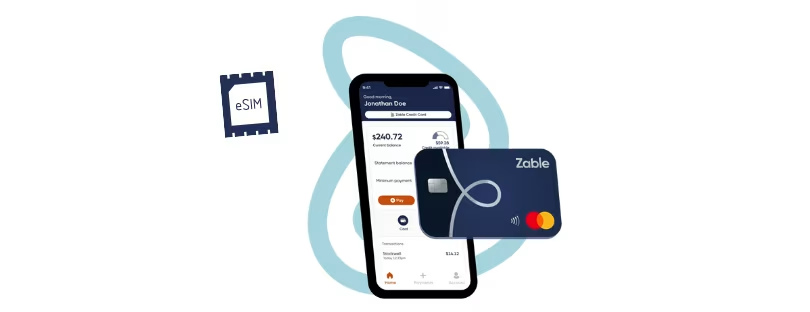
eSIM vs Standard SIM card: Which is Better?
We’re all familiar with the term SIM card, which refers to the device that connects your phone to a mobile network operator (MNO) so you may utilize wireless service and get a special phone number. But in recent times, the term “eSIM” has proliferated to denote a novel method of mobile connectivity for users and IoT devices. esim vs sim
The embedded SIM card, or the eSIM, is built into the phone board and can be linked with many of the top MNOs to improve signal quality for people around the world. But is it really better than a regular SIM? Let’s find out.
Here we will explore the benefits of an eSIM, how it differs from a standard SIM, and which devices and networks support it.
What is an eSIM?
An eSIM, which is essentially a tiny chip inside your phone, functions similarly to the NFC chip used in payment systems like AppIe Pay and Google Pay.
The information available on an eSIM is rewritable and backed by the GSMA. It means you can choose to switch operators with just a quick phone call. It takes a few minutes to link devices with eSIMs to a mobile account and add them to any data plan.
What are the benefits of an eSIM? esim vs sim
Using eSIM technology allows you to change operators remotely, straight from your phone, without acquiring a new SIM card. And because it’s embedded inside the phone, eSIM can’t be physically damaged or lost.
It also allows you to store multiple profiles or numbers on a single device and easily switch between them. This is perfect for anyone who might need an extra number, for instance, for travel or business.
Other notable advantages include:
- Convenience: You can download an eSIM anywhere you have a network connection.
- Low Cost: eSIM uses less space, making it cheaper than traditional SIM technology.
- Simple Installation: It takes only a couple of minutes to download and install data on an eSIM.
- Ease of Management: IT teams can quickly and easily provision and deploy new devices with eSIM by providing a streamlined user experience for managing cellular connectivity.
Device bundling becomes much easier with eSIM, allowing customers to conveniently add new devices to their plans without visiting a store or waiting for a physical SIM card to be mailed.

This opens up new revenue opportunities for mobile operators as their customers scale up their plans by adding new devices that require data.
How it’s different from a standard SIM esim vs sim
Most SIM cards are locked to a single network, making it impossible for you to change them on your own without assistance from the carrier. On the other hand, an eSIM can be used with any supported device and activated and deactivated over the phone without intervention from the carrier.
Over the years, a standard SIM has become smaller, starting with the Mini-SIM, then the Micro-SIM, and finally the Nano-SIM, which is now the industry standard for these physical chips. With an eSIM, size reduction is one of the main advantages over a traditional SIM. While the Nano-SIM may appear tiny and difficult to insert into your smartphone, eSIMs are even three times smaller.

Device and network support for eSIM
eSIM is supported by some of the biggest MNOs around the world. It is often activated on your phone by scanning a QR code provided to you when you buy the plan directly from the operator. Some eSIM-compatible carriers also have apps that allow users to purchase plans and customize pricing.
Although most modern flagships now support eSIMs, not all phones are compatible with them. Some of the devices compatible with eSIM include:
- Samsung Galaxy S20
- Google Pixel
- Microsoft Surface Duo and
- Apple’s iPhone 12 and 13 series
A complete list of eSIM Supported Phones finds out here.
eSIMs will also be great for tablets and laptops, where frictionless connectivity will be the standard. According to Vodafone, eSIMs will enable more connected devices simply because they don’t take up as much space within a device. As a result, this allows fitness trackers, smart watches, or even glasses to have stand-alone 4G or 5G connectivity in a way they weren’t able to before.
Driving eSIM adoption
The adoption of eSIM by consumers and businesses will depend partly on technology providers’ capacity to support the new technology. By 2030, all new smartphones will support eSIM, and other linked technologies will probably do the same.
Telco operators are also responsible for ensuring their networks can handle the technology and offer a positive customer experience to businesses and consumers who want to adopt it. Updating your customer support systems and investing in a chatbot building platform that will automate communication and provide enhanced eSIM management capabilities can achieve that.
This, in turn, will simplify the adoption of eSIM technology for customers and drive new use cases across the telco industry.
If you are travelling abroad and need SIM cards choose between daily, monthly or data packages without expiration or if prefer instant connectivity, get an eSIM. Each Android Smartphone Can Be Upgraded To ESIM With ESIM.Me
- AIRALO
-
eSIM for
Europe
39 countries
-
1 GB – 7 days – €4.27
3 GB – 30 days – €11.09
10 GB – 30 days – €31.57
- AIRHUB
-
eSIM for
Europe
34 countries
-
1 GB – 7 days – €2.99
3 GB – 30 days – €5.12
10 GB – 30 days – €11-09
- aloSIM
-
eSIM for
Europe
32 countries
-
1 GB – 7 days – €5.00
3 GB – 30 days – €13.00
10 GB – 30 days- €36.00
- GigSky
-
eSIM for
Europe
36 countries
-
1 GB – 7 days – €6.99
3 GB – 15 days – €11.19
10 GB – 30 days – €27.99
- iRoamly
-
eSIM for
Europe
39 countries
-
1 GB – 7 day – €6.83
3 GB – 15 days – €10.24
10 GB – 30 days – €18.77
- Maya Mobile
-
eSIM for
Europe
34 countries
-
1 GB – 7 days – –
5 GB – 15 days – €5.99
10 GB – 30 days- €13.99
- NOMAD
-
eSIM for
Europe
36 countries
-
1 GB – 7 days – €4.71
3 GB – 15 days – €10.27
10 GB – 30 days – €15.41
- UBIGI
-
eSIM for
Europe
29 countries
-
500 MB – 1 day – €2.00
3 GB – 30 days – €8.00
10 GB – 30 days – €19.00
- VOIA
-
eSIM for
Europe
34 countries
-
1 GB – 7 days – €2.69
3 GB – 15 days – €5.05
10 GB – 30 days- €11.70
The Best eSIM Finder brings together 100+ providers in one place, giving you a clear view of everything from data limits and business options to tethering, crypto payments, coverage, travel extras, refund policies, discounts, and reviews—so you don’t just compare plans, you understand which one truly fits your needs. Start exploring today and find the plan that fits you best.


















